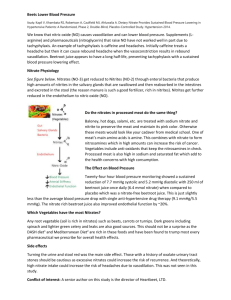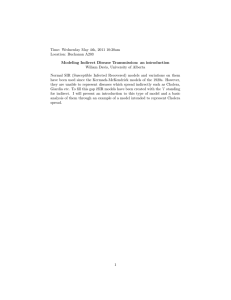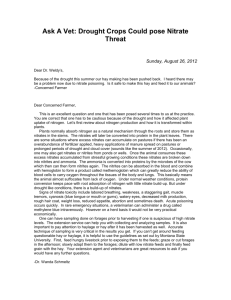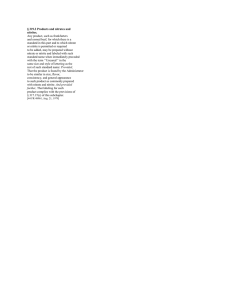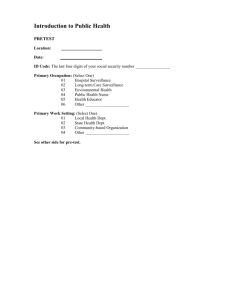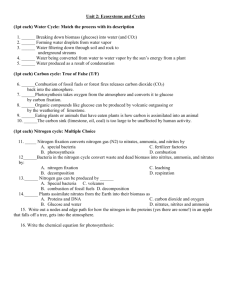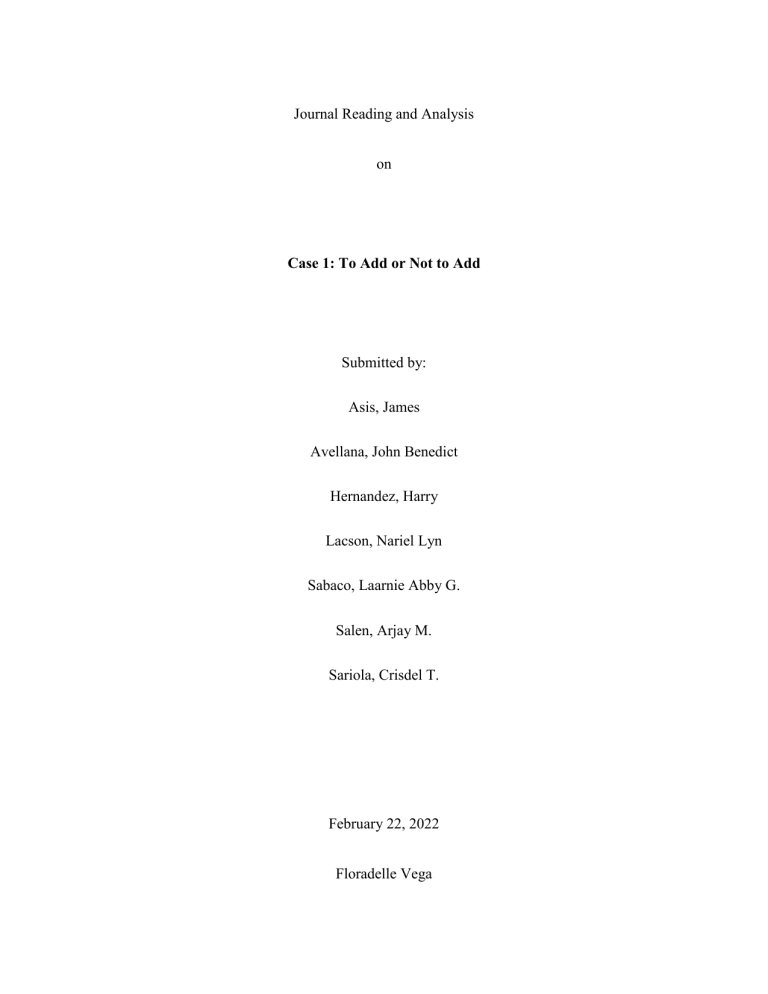
Journal Reading and Analysis on Case 1: To Add or Not to Add Submitted by: Asis, James Avellana, John Benedict Hernandez, Harry Lacson, Nariel Lyn Sabaco, Laarnie Abby G. Salen, Arjay M. Sariola, Crisdel T. February 22, 2022 Floradelle Vega Introduction Health is wealth—It is the key factor in life that people need to establish for themselves. Being healthy requires effort and discipline with regards to exercise, balanced diet, and selecting proper food intake. As the time passes, many products and spices emerged to raise the food quality, along with these are the discovery of new ways of preserving food. Despite the benefits, it could also beget such negative effects onto our body. There’s a lot of means and ways that can be utilized in food preservation but the most used way in preserving meat is by adding nitrites and nitrates as its preservative agents. These agents give the meat a pinkish color, distinct aroma, and flavor. Nitrite contains both antibacterial and antioxidant property which provide longer shelf-life to the cured meats by fighting bacteria that spoils the meat. Plus, it also gives food safety by the means of inhibiting the growth of Clostridium botulinum, the bacteria that causes botulism which is one of the deadliest foodborne illness. Despite its benefits, it is known that nitrates and nitrites can transform into nitrosamines when exposed to high heat in the presence of amino acids. The majority of nitrosamines are known as carcinogens which can cause negative health consequences. This is the main reason why the Food and Drug Authority (FDA) regulates the amount of these preservatives in the cured meats like the bacon to ensure that our exposure to these compounds remains well within permissible levels. Bacon is a salt-cured thin-sliced pork that is normally made from the belly or less fatty sections of the back. Most of the processed meat, like bacon, contain nitrites and nitrates which are the salts from either natural or chemical sources which are added onto the meat to act as a preservative and prolong its shelf-life. But exposing bacon to high heat which happens when cooking, it transforms the nitrites into nitrosamines which is a form of carcinogen, thus the consumption of these is harmful to the body and worst, it could lead to cancer. Taking everything into consideration, adding nitrites and nitrates as preservative agent for bacon encompasses both positive and negative attributes. This refers to prolonging the shelf-life of the meat and providing distinct color and smell however, it may also develop carcinogenic compound the causes cancer if it not handled/ cooked properly. Background Information Food preservation is a technique for preserving foods at a certain quality level. To meet increasing growth of demands in economic preservation, a variety of modern preservation techniques are being developed, and food preservation is the act of treating and preserving food to prevent or slow down expiration. According to research conducted by Surwase, Mohan, Kademani, & Bhanumurthy, (2014), Preservation usually involves preventing the growth of bacteria, yeast, fungi, and other micro-organisms, as well as retarding the oxidation of fats which cause rancidity. Food preservation involves using a range of chemical preservatives such as citric acid, sodium nitrite, nitrates, and nitrite compounds to prolong the life of perishable products. It enhances the color, taste, look, and texture of food by adding manufactured additives. These food additives can be organic or synthetic depending on the required additive of a specific product. In fact, you want nitrates and nitrites added to your food. They reduce the risk of foodborne illness, like botulism, which can otherwise be deadly (C. Mohr, 2016). Botulism is an uncommon but dangerous disease caused by a substance that targets the body's nerves, causing breathing difficulties, muscular paralysis, and even death. Botulinum toxinproducing bacteria can be found in many places naturally inside the spores, which function as protective coverings. Spores assist bacteria in surviving in the environment, especially in harsh environments. Despite the fact that synthetic and artificial preservatives are generally regarded as safe, some of them have significant and potential fatal side effects. It implies that, despite being labeled as acceptable, we can't escape its drawbacks as a food additive. One of the downsides of food preservation is that it typically results in the loss of nutrients, and another disadvantage is that it can result in food poisoning, which can be dangerous due to preservative reactions. There are some commonly used preservatives along with health hazards such as benzoic acid, Sulfite, Sodium specially Nitrates. Is it better to add nitrate or not? A recent study by Anand and Sati (2013), Nitrates, upon ingestion, are converted to nitrites that can react with hemoglobin to produce methemoglobin, a substance that can cause loss of consciousness and death, especially in infants. Proteins in the stomach react with nitrites and produce nitrosamines, substances that are carcinogenic. Nitrates and nitrites are nitrogen-oxygen chemical compounds that are dominantly used to be a food preservative. N-nitroso compounds (NOC) are formed when nitrate and nitrite react with amines and amides in a strong acidic environment that form nitrosamines and are known to cause cancer in animals and may cause cancer in humans. According to WHO (2016), though IARC states that dietary nitrates or nitrites found primarily in meat sources are probably carcinogenic to humans, conclusions from epidemiologic studies are somewhat mixed. High nitrate intake may be associated with a decreased risk of gastric cancer, whereas nitrite intake may increase the risk of glioma and thyroid and gastric cancers. Alternatives This presents the alternatives that have direct and indirect bearing with the current case which somewhat provide considerable information that shows significant relevance to the present case. This also includes some constraints that show significant relevance to the current case. Lessen the added preservatives like nitrate and nitrites to bacons. There are several nitrate consumption restrictions that aren't detrimental to humans. They are used to stabilize processed meat and cheese, such as bacon and hams, in the food industry. The maximum number of nitrites and nitrates that can be added as a food additive during food processing must be regulated. According to the European Commission’s former Scientific Committee for Food (SCF) and the Joint FAO/WHO Expert Committee on Food Additives (JECFA), the current acceptable daily intake (ADI) for nitrites are 0.06 and 0.07 milligrams per kilogram of body weight per day, respectively. In the case of nitrates, both organizations establish the ADI at 3.7 mg/kg bw/day. Meat-based nitrate consumption has been linked to several health hazards. When these chemicals are ingested, around 60%–70% of them are easily digested and eliminated in urine. In humans, roughly 3% of nitrate is excreted as urea and ammonia in the urine. Nitrates can also make it through the stomach and into the circulatory system. Under acidic stomach and bowel cancer environments, a range of highly bioactive reactive nitrogen oxide species are produced that can be dangerous to human especially to kids and pregnant women. Vegetarian bacon It is made from vegetables, like carrot and eggplant, and grains, such as wheat. Tempeh and soy chunks, both derived from soy, are used to make homemade bacon-like strips. Both tempeh and tofu contain much less fat than bacon and are cholesterol-free. Toddlers can usually consume soy products after the age of two years, but consult a pediatrician before adding soy to their diet. You can also substitute with mushroom, which have a meatiness in taste, is very low in fat, is rich in vitamin B, and cholesterol-free. Solution Leaking the news to the press is the best possible solution to the present problem. According to the Food and Drug Administration adding nitrates and nitrites in bacon is not very toxic to adults. However, eating bacon can cause harm in the body because certain disease organism such as those that manufacture, botulism toxin has been known to grow in bacon. Also, when the nitrites manufactured in our mouth are swallowed, one of the things that can happen is that they react in the strongly acidic environment of the stomach to form nitrosamines – some of which are carcinogenic and have been linked with bowel cancer based to Dowden, A. (n.d.). According to World Health Organization, botulinum or botulism toxin are one of the lethal substances known. It blocks the nerve functions and can lead to respiratory and muscular paralysis. Also, there are side effects that may experience like headaches, palpitation, and etc. It is good to introduce your baby to a variety of new foods however there are certain foods such as ham, bacon, sausages etc., which should be introduced at a certain age and on consultation with the pediatrician. Bacon has high amounts of saturated fat, sodium, and food additives, like nitrites (1) (2) (3), making it unsuitable for infants below the age of 12 months. The baby’s kidneys are not fully developed to cope with the high salt food (4). Other additives in bacon may also adversely affect the baby’s body Patwal, S. (2015, July 13). Hence, the group decided to inform the media what behind about the processing of the bacon on that company also to let other be knowledgeable about this. Putting everything in to account adding nitrates and nitrites can be consumable but not generally recommended. References Oaklander, M. (2015, October 29). Why Nitrate-Free Bacon Doesn’t Exist. Time. Retrieved from https://time.com/4092912/nitrate-nitrite-bacon-cancer-meat/ Jinpeng Li, E. A. (2022, January 21). Preservatives – Exploring nitrate & nitrite safety. Center for Research on Ingredient Safety. Retrieved from https://www.canr.msu.edu/news/preservativesexploring-nitrate-nitrite-safety What are Nitrites/Nitrates? (2017, April 12). TheMeatWeEat. Retrieved from https://meatscience.org/TheMeatWeEat/topics/meat-safety/article/2017/04/12/what-are-nitritesnitrates Chris Mohr, P. D. (2019, February 25). Why this nutritionist wants you to stop worrying about nitrates and nitrites causing cancer. Men's Health. Retrieved February 22, 2022 from https://www.menshealth.com/nutrition/a19520561/stop-worrying-about-nitrates-and-nitrites/ Centers for Disease Control and Prevention. (2021, June 1). About botulism. Centers for Disease Control and Prevention. Retrieved February 22, 2022 from https://www.cdc.gov/botulism/general.html#:~:text=Botulism%20(%E2%80%9CBOT%2Dchoo %2D,butyricum%20and%20Clostridium%20baratii%20bacteria. Journal Reading and Analysis on Case 2: You Can’t Do Everything At Once Submitted by: Asis, James Avellana, John Benedict Hernandez, Harry Lacson, Nariel Lyn Sabaco, Laarnie Abby G. Salen, Arjay M. Sariola, Crisdel T. February 22, 2022 Floradelle Vega Introduction Water plays a vital role in life especially to humans. It is very crucial to human health and well-being thus it is correlated on safe drinking water, sanitation, and hygiene. Safe water and sanitation are not only essential for good health, but also play a part in livelihoods, agriculture, education, and decency, as well as helping to build resilient communities in healthy settings. Being exposed to contaminated water brings you at high risk of health problems. Drinking contaminated water causes ailments including diarrhea, amoebiasis, cholera, NTDs, such as trachoma, soil-transmitted helminths, and schistosomiasis, which can be prevented with safe and sufficient water sanitation and hygiene. Cholera is an acute diarrheal disease infection caused by the bacterium Vibrio cholerae, which can be contracted by eating or drinking contaminated food or water. Cholera continues to be a global public health hazard, as well as an indicator of inequity and a lack of social development. According to researchers, there are million cases of cholera each year, with hundreds of thousand fatalities globally as a result of the disease. Cholera is a life-threatening disease that causes severe acute watery diarrhea and severe dehydration. After consuming infected food or water, symptoms might appear anywhere from 12 hours to 5 days later. Children and/ or adult can acquire this disease, and if left untreated it can kill within hours. Majority of the people infected with Vibrio cholerae do not exhibit symptoms. Majority of the people infected with Vibrio cholerae do not exhibit symptoms. Furthermore, the bacteria present in their feces lasts for 1-10 days following infection, as a result, the bacteria are released into the environment, which increases the risk of contamination and infection of other people. Recuperation to Cholera epidemic requires prevention and control measures with the help of outside of the health sector, therefore collaboration with partners from other sectors is pertinent. Multi-sectoral cholera control plans are a helpful instrument for bringing together all key sectors and establishing channels of communication and cooperation that will lead to the eradication and treatment of cholera by providing access to clean water, sanitation facilities, and proper hygiene practices. Background Information Cholera is an infectious disease that produces severe watery diarrhea and, if left untreated it will cause dehydration and death to the infected person. Cholera is common in the location of Africa, south Asia, and Latin America. It is transmitted by consuming food or water infected with the bacteria Vibrio cholerae. According to Wong (1999), Vibrio cholerae is the etiological agent of cholera, an epidemic disease of significant public health importance owing to its rapid spread in areas with poor sanitation and hygiene, and its severe consequences when access to health care is limited. Humans get sickened with V. cholerae by taking contaminated water and food. Cholera outbreaks linked to the consumption of leftover rice, raw fish, vegetables grown with water containing human wastes, municipal water supplies, foods and drinks sold by street vendors. According to a 2017 report by World Health Organization (WHO), 2.1 billion people lack access to a safe and reliable drinking water supply at home. Eighty-eight percent of the four billion annual cases of diarrhea reported worldwide have been attributed to a lack of sanitary drinking water According to WHO (2021), Cholera remains a global threat to public health and an indicator of inequity and lack of social development. Researchers have estimated that every year, there are roughly 1.3 to 4.0 million cases, and 21 000 to 143 000 deaths worldwide due to cholera. The number of cholera cases reported to WHO has continued to be high over the last few years. During 2019, 923 037 cases, 1911 deaths were notified from 31 countries. Most individuals infected with V. cholerae do not show any symptoms within the development of the bacteria. The viruses that are present in their intestines for 1-10 days after infection and are shed back into the environment, potentially infecting other individuals. Cholera is a disorder that can be endemic or epidemic. Cholera outbreaks and epidemics can happen in both endemic and non-endemic nations. It is a highly contagious illness that causes severe watery diarrhea. After swallowing infected food or drink, the symptoms might appear after 12 hours to 5 days after. The symptoms of cholera watery diarrhea, vomiting, leg cramps and rapid loss of body fluids leads to dehydration and shock. Cholera is a disorder that is usually easy to be cured. The majority of patients can be effectively treated with oral rehydration solution. Severely dehydrated patients are at risk of shock and require the rapid administration of intravenous fluids. These patients are also given appropriate antibiotics to diminish the duration of diarrhea, reduce the volume of rehydration fluids needed, and shorten the amount and duration of V. cholerae excretion in their stool (WHO 2021). During a cholera outbreak, immediate access to treatment is necessary. In addition to bigger treatment centers that can give intravenous fluids and 24hour care, oral rehydration should be accessible in communities. Alternatives This presents the alternatives that have direct and indirect bearing with the current case which somewhat provide substantial information that shows significant relevance to the present case. This also includes some constraints that show significant relevance to the current case. Request a portable water purifier The use to purify water for drinking from untreated sources. Their major job is to get rid of bacteria, as well as residual sediments and certain unpleasant or hazardous compounds. With the help of purification, the waters unwanted chemical compounds, organic and inorganic elements, and biological pollutants are removed. Water purification serves several purposes, one of which is to produce safe drinking water specially to villages with no access to mineral water. Contaminants such as unhealthy particles, parasites, bacteria, algae, viruses, and fungus are reduced during the purification process. Water purification also meets the needs of medical, pharmacological, chemical, and industrial applications for clean and potable water (Ambulkar, 2011). So, a contaminated water is now safe to drink after being purified by the water purifier using the process of distillation and deionization. Solution Participate in Clean-up Efforts Global water conditions are declining, more people will soon have to rely on polluted water sources unless we make a concerted effort to clean our water supply. Take part in local clean-up days to help keep trash out of the water. Clean up litter along a river, stream or beach, or along city streets or highways. If many participants, use this opportunity to let them know how the methods used to dispose of waste in the proper containers can help our safety of water supply. Better yet, organize a cleaning day where it is closer to the source of our water, which if we do can prevent degeneration and maintain the cleanliness of the water supply. It will also serve as a way for all participants to learn together for safety. When this dirty water is used to grow food for our community, the contaminants affect the food supply and health. And also when water supplies are improved and sustainable, it significantly enhances a community’s economic growth and reduces poverty. According to Environmental Protection Agency (EPA) and the Army are finalizing a Clean Water Rule to protect the streams and wetlands we rely on for our health, our economy, and our way. The rule only protects waters historically covered under the Clean Water Act. It doesn’t interfere with private property rights, and it only covers water, not land use. It also doesn’t regulate most ditches, doesn’t regulate groundwater or shallow subsurface flows, and doesn’t change policy on irrigation or water transfers. These are just a few of the many reasons why clean water and this rule are importantly of life. Water is most fundamental in shaping the land and regulating the climate. It is one of the most important resources that profoundly influence life. Water quality is the most fundamental controlling factor when it comes to health and the state of diseases in both humans and animals. According to WHO, about 80% of all the human diseases in human beings are caused by water. The concept and theory of water quality is very broad since it is influenced by many factors. Water quality is based on the intended uses of water for different purposes, that is, different water uses require different criteria to be satisfied. In water quality analysis, all of the accepted and unaccepted values must be clearly defined for each quality variable. If the quality variables meet the pre-established standards for a given use is considered safe for that use. When water fails to meet these standards, it must be treated if possible before use. Recommendation References
